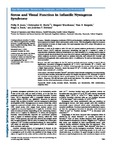Stress and Visual Function in Infantile Nystagmus Syndrome
| dc.contributor.author | Jones, PH | |
| dc.contributor.author | Harris, Chris | |
| dc.contributor.author | Woodhouse, JM | |
| dc.contributor.author | Margrain, TH | |
| dc.contributor.author | Ennis, FA | |
| dc.contributor.author | Erichsen, JT | |
| dc.date.accessioned | 2017-02-03T17:29:57Z | |
| dc.date.available | 2017-02-03T17:29:57Z | |
| dc.date.issued | 2013-12-05 | |
| dc.identifier.issn | 1552-5783 | |
| dc.identifier.issn | 1552-5783 | |
| dc.identifier.uri | http://hdl.handle.net/10026.1/8351 | |
| dc.description.abstract |
PURPOSE: Infantile nystagmus syndrome (INS) is an involuntary oscillation of the eyes that has been reported to impair vision and worsen under stress. This investigation aimed to measure visual function in terms of visual acuity (VA) and response time (RT), when INS subjects are placed under stress. METHODS: A total of 23 subjects with INS and 20 control subjects performed a 2-alternative forced choice (2AFC) staircase procedure identifying the gap in a Landolt C, under 4 experimental conditions: initial acclimatization (A); task demand (TD), during which subjects received a small electrical shock for every incorrect answer; anticipatory anxiety (AA), during which subjects received a small shock at random intervals; and relaxed (R). Arousal was monitored with galvanic skin conductance (SkC). In addition to VA and eye movements, RTs were recorded. RESULTS: The SkC was higher in the TD and AA periods and lower during A and R. Shock significantly increased nystagmus amplitude (P < 0.01) and intensity (P < 0.007), and reduced foveation periods (FPs, P < 0.022). In both groups, VA was not reduced, but showed a slight improvement. However, shock increased RT (P < 0.009), and INS subjects were slower than controls (P < 0.0005). CONCLUSIONS: Increased arousal ("stress") provoked more intense nystagmus eye movements. As seen in other studies, stress did not reduce VA despite the shorter FPs. Although VA and FP can correlate across subjects, there would appear to be little correlation, if any, within a subject. However, RTs did increase with stress and shorter FPs, which may have an adverse impact on the visual performance of those with INS. | |
| dc.format.extent | 7943-7943 | |
| dc.format.medium | Electronic | |
| dc.language | en | |
| dc.language.iso | eng | |
| dc.publisher | Association for Research in Vision and Ophthalmology (ARVO) | |
| dc.subject | visual acuity | |
| dc.subject | arousal | |
| dc.subject | shock | |
| dc.subject | foveation | |
| dc.subject | eye movements | |
| dc.subject | skin conductance | |
| dc.subject | response time | |
| dc.title | Stress and Visual Function in Infantile Nystagmus Syndrome | |
| dc.type | journal-article | |
| dc.type | Comparative Study | |
| dc.type | Journal Article | |
| dc.type | Research Support, Non-U.S. Gov't | |
| plymouth.author-url | https://www.webofscience.com/api/gateway?GWVersion=2&SrcApp=PARTNER_APP&SrcAuth=LinksAMR&KeyUT=WOS:000328133800014&DestLinkType=FullRecord&DestApp=ALL_WOS&UsrCustomerID=11bb513d99f797142bcfeffcc58ea008 | |
| plymouth.issue | 13 | |
| plymouth.volume | 54 | |
| plymouth.publication-status | Published | |
| plymouth.journal | Investigative Opthalmology & Visual Science | |
| dc.identifier.doi | 10.1167/iovs.13-12560 | |
| plymouth.organisational-group | /Plymouth | |
| plymouth.organisational-group | /Plymouth/Faculty of Health | |
| plymouth.organisational-group | /Plymouth/Research Groups | |
| plymouth.organisational-group | /Plymouth/Research Groups/Centre for Brain, Cognition and Behaviour (CBCB) | |
| plymouth.organisational-group | /Plymouth/Research Groups/Centre for Brain, Cognition and Behaviour (CBCB)/Brain | |
| plymouth.organisational-group | /Plymouth/Users by role | |
| dc.publisher.place | United States | |
| dc.identifier.eissn | 1552-5783 | |
| dc.rights.embargoperiod | Not known | |
| rioxxterms.versionofrecord | 10.1167/iovs.13-12560 | |
| rioxxterms.licenseref.uri | http://www.rioxx.net/licenses/all-rights-reserved | |
| rioxxterms.type | Journal Article/Review |


